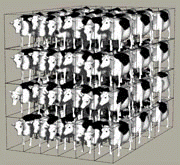Department of Animal Science
Date of this Version
1986
Abstract
Some of the factors involved in inter-flock or breed improvement programs are discussed. Such programs are complicated by the fact that sheep and goats produce a wide range of products under diverse environmental, management and economic circumstances. This leads to problems in defining realistic breeding objectives arising from determining the beneficiaries of genetic improvement, the major genetic decision makers in the industry and the relative importance of the various productive characteristics. The implementation of functional performance recording systems, breeding systems to generate young sire replacements, and testing systems to disseminate genetic improvement, also depend on the conditions under which the breeding programs operate. Alternative means of estimating genetic improvement in breeding programs through comparisons of progeny by sires repeated over time or from parents of different ages, and the use of artificial insemination (AI), multiple ovulation and embryo transfer (MOET) and mixed model methodology (BLUP) are also briefly addressed.


Comments
Published in 3rd World Congress on Genetics Applied to Livestock Production, edited by Gordon E. Dickerson and Rodger K. Johnson, 4 vols. (Lincoln: University of Nebraska Institute of Agriculture and Natural Resources, 1986). Copyright © 1986 Board of Regents University of Nebraska.